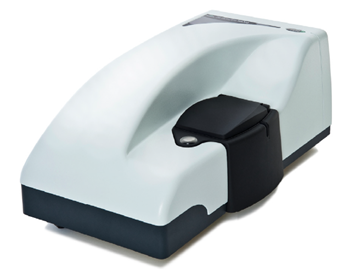Malvern Zetasizer Nano ZS
Manufacturer: Malvern Instruments GmbH
Name: Zetasizer Nano ZS
Device type: Particle analytics
Specifications
Dimensions D × W × H: 60 x 32 x 26 cm3
Weight: 19 kg
Temperature control range: 0°C – 90°C ± 0.1°C**
Condensation control: Purge using dry air
Laser: 4 mW, 633 nm
Correlator: 25 ns – 8000 s, max 4000 channels
Parameter measured: Particle size, zeta potential, molecular weight
PARTICLE SIZE MEASUREMENTS
Absolute sensitivity (Toluene kcps): 150
Range: 0.3 nm – 10 µm*
Min. sample volume: 12 µL
Min. concentration, protein: 0.1 mg/mL, 15 kDa protein
Min. concentration, forward angle: 10 mg/mL, 66 kDa protein
Max concentration: 40% w/v*
Measurement angles: 13° + 173°
Analysis algorithms***: General purpose NNLS, multiple narrow modes, protein
ZETA POTENTIAL MEASUREMENTS
Sensitivity: 10 mg/mL, 66 kDa protein
Zeta potential range: > ± 500 mV
Mobility range: > ± 20 µ.cm/V.s
Max. sample concentration: 40% w/v*
Min. sample volume (using diffusion barrier): 20 µL
Max. sample conductivity: 200 mS/cm
Signal processing: M3-PALS
MOLECULAR WEIGHT MEASUREMENT
Range as estimated from DLS: <1000 Da – 2×107 Da*
Range as estimated by Debye plot: <1000 Da – 2×107 Da*
* Sample dependent
** 0.1° at 25°C, 0.2° at 2°C, 0.5° at 90°C
*** Contin algorithm in research software option
Description
- A three-in-one device that measures not only particle size, but also particle charge (zeta potential) and molecular weight in solution.
- Technologies incorporated:
1. Dual angle Dynamic Light Scattering (DLS, for measuring particle size)
2. Non-Invasive Back-Scatter (NIBS, for measuring particle size)
3. Static Light Scattering (SLS, for measuring molecular weight)
4. Electrophoretic Light Scattering (ELS)
5. Mixed mode measurement, phase analysis light scattering (M3-PALS, for measuring zeta potential) - The NIBS optics and M3-PALS technology ensure a wide size and concentration range, which reduces time and effort for sample preparation.
- The NIBS technology illuminates a larger number of particles and uses efficient fiber detection, giving 100 times the sensitivity of conventional optics. Measuring a larger number of particles eliminates number fluctuations, giving a more stable signal and significantly increasing the largest particle size that can be measured.
- The diffusion barrier technique improves the stability of the charge measurement of proteins, and dramatically reduces the volume of sample required.
- Forward scattering angle for the enhanced detection of aggregates.
- Measurement in high salt and non-aqueous media.
- For further information, please visit:
https://www.malvernpanalytical.com/en/assets/MRK1839_tcm50-17228.pdf


